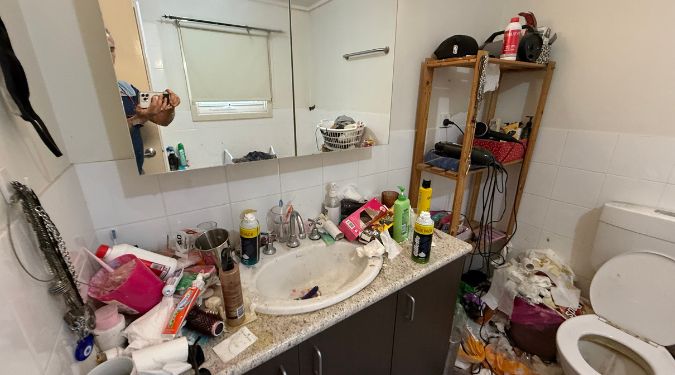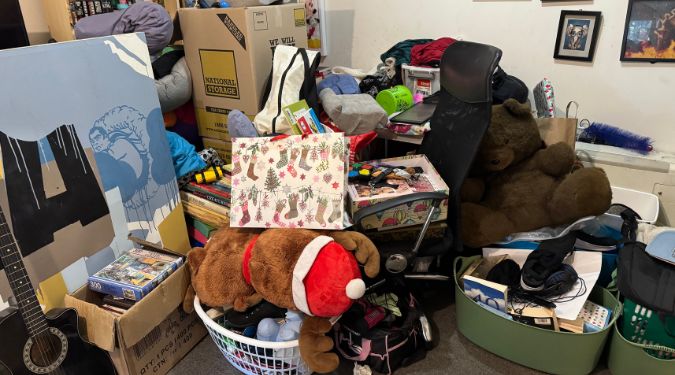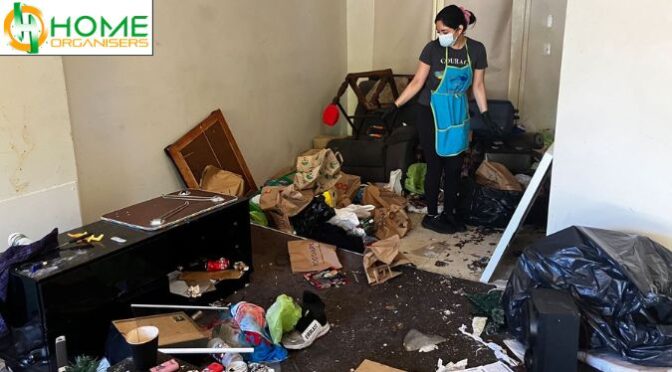Many of us have faced the frustration of a cluttered home. You might have tried tidying, donating, or even hiring help, only to find that the clutter keeps returning. For some people, clutter isn’t just about mess — it can be linked to deeper issues, such as trauma, mental health, and emotional challenges. When the usual methods don’t work, a trauma-informed approach might be what you need.
What is a Trauma-Informed Approach?
A trauma-informed approach understands that clutter and hoarding are often symptoms of past or ongoing trauma. Trauma can come from many sources — difficult childhood experiences, loss, anxiety, or stressful life events. For people affected by trauma, possessions can become more than things; they might represent safety, memories, or control. This means that simply throwing things away can feel overwhelming or even unsafe.
Instead of rushing to declutter, a trauma-informed method focuses on understanding these feelings. It offers support and patience, helping people gently work through their attachment to belongings. This kind of approach respects that healing and change take time.
How Trauma Affects Clutter and Hoarding
Clutter can be linked to mental health in many ways. For example:
- Anxiety and Stress: Some people hold on to items because they fear losing something important or making the wrong decision.
- Depression: Low energy or motivation can make tidying difficult.
- Post-Traumatic Stress Disorder (PTSD): Past trauma can cause people to cling to possessions as a way to feel safe.
- Grief or Loss: Items may remind someone of a loved one, making it hard to let go.
These mental and emotional struggles create a cycle that makes decluttering feel impossible without the right support. If you are seeking hoarding help, NDIS programs can assist people with trauma and hoarding behaviours through specialist services.
Health Impacts of Cluttered Homes
Living in a cluttered or hoarded home isn’t just a matter of appearance — it can seriously affect physical health. Dust, mould, and pests often thrive in cluttered spaces, which can worsen allergies, asthma, and other respiratory problems. A cluttered home can also increase the risk of trips and falls, especially for children, older adults, or people with mobility issues.
Beyond physical health, clutter can impact sleep quality and contribute to feelings of exhaustion. When your environment is overwhelming, your body’s stress levels can stay high, which affects your overall well-being.
This is why cleaning for trauma requires more than surface-level tidying — it needs sensitivity to the emotional challenges involved.

Emotional and Family Effects
Clutter doesn’t just affect the person living in the home—it can impact the whole family. Living in a messy environment often leads to frustration, embarrassment, and tension between family members. Children might feel unsafe or distracted, and relationships can suffer due to misunderstandings around clutter and control.
When someone struggles with clutter due to trauma, family members may unintentionally add pressure or judgment, making the person feel isolated or defensive. A client-centred declutter approach helps families understand the emotional side of clutter, encouraging empathy instead of criticism.
How Clutter Affects Productivity and Mood
A cluttered home can make it hard to focus and be productive. When your space is full of stuff, your brain can feel overwhelmed by the visual chaos. Simple tasks can take longer, and you might feel distracted or stressed.
Studies show that clutter can negatively impact mood, increasing feelings of anxiety and sadness. On the other hand, a tidy, organised environment helps improve concentration and lifts spirits. By addressing clutter in a trauma-informed way, people can gradually reclaim their space and create a calming atmosphere that supports mental clarity.
Well-Being and Self-Care Through Decluttering
Decluttering with a client-centred declutter approach isn’t just about clearing space; it’s about supporting your emotional wellbeing. This approach encourages small, manageable steps that build confidence and reduce overwhelm. It’s important to recognise and respect your feelings throughout the process — whether that’s fear, sadness, or guilt about letting go.
Self-care becomes central in this process. Taking breaks, celebrating small wins, and using coping strategies like mindfulness or journaling can make a big difference. Over time, these healthy habits support not only a clutter-free home but also a healthier mindset.

Financial and Wealth Considerations
Clutter can also have financial impacts. When homes are cluttered, it’s easy to lose track of what you own, leading to unnecessary purchases or missed bills. Clutter can make it difficult to find important documents, resulting in late fees or missed opportunities.
Moreover, some people hold on to items with the hope that they might be valuable one day. However, keeping too much can cost more in storage fees, cleaning costs, or even harm your ability to rent or sell a property. By gently working through clutter with support, including hoarding help NDIS programs, you can free up space and money, reducing stress related to your finances.
Why Traditional Decluttering Methods May Fail
Many people try quick fixes like “declutter challenges” or “one-hour cleanups.” While these can work for some, they often don’t address the emotional roots of clutter. When trauma or anxiety are involved, these fast solutions can feel overwhelming or even harmful.
People might feel judged or pressured to get rid of things before they’re ready, which can increase resistance and cause setbacks. Without emotional support, clutter can quickly return, leaving people stuck in the same cycle.
If you or someone you know needs hoarding help, NDIS offers support options tailored to individual needs, which can be part of a broader trauma-informed care plan.
What to Expect From a Trauma-Informed Decluttering Process
A trauma-informed decluttering journey starts with understanding and compassion. It usually involves:
- Building Trust: Working at your pace, with no pressure to rush decisions.
- Setting Small Goals: Breaking down tasks into manageable steps.
- Understanding Triggers: Recognising emotional responses to certain items.
- Emotional Support: Offering encouragement and tools to manage stress.
- Family Inclusion: Helping loved ones understand the process and how to support.
- Long-Term Planning: Creating sustainable habits to maintain a clutter-free space.

Professionals trained in this approach provide not only practical help but also emotional guidance, ensuring a safer and more successful decluttering experience. This combination of practical and emotional support is at the heart of cleaning for trauma.
Taking the First Step
If you’ve tried everything and still feel overwhelmed by clutter, it might be time to try a trauma-informed approach. Recognising the connection between clutter and emotional well-being is the key to breaking the cycle.
Decluttering with care and support can improve your health, mood, relationships, and financial well-being. Most importantly, it can help you create a home where you feel safe, calm, and in control.
If this sounds like the right path, consider seeking professionals who understand the client-centred declutter and cleaning for trauma methods. With patience and support, lasting change is possible — and your home can become a space that truly supports your wellbeing.
Ready to reclaim your space with a trauma-informed, client-centred declutter?
Call us today on 03 8583 9103 or email nancy@homeorganisers.com.au.
Visit https://homeorganisers.com.au to learn more and get started.
FAQs: Understanding the Trauma-Informed Approach to Managing Clutter
- 1. What is a trauma-informed approach to decluttering for people struggling with hoarding?
A trauma-informed approach recognises that clutter and hoarding are often linked to past or ongoing emotional trauma. Instead of just focusing on tidying, this approach supports individuals with patience and understanding, addressing the emotional attachments to possessions and helping clients feel safe throughout the decluttering process.
- 2. How does a client-centred declutter differ from traditional organising services?
A client-centred declutter puts the person’s feelings, pace, and needs at the forefront. Unlike traditional methods that may focus only on quick results, this approach builds trust and works with clients to set manageable goals, offering emotional support and avoiding pressure or judgement.
- 3. Can cleaning for trauma support improve mental health during home decluttering?
Yes. Cleaning for trauma acknowledges the emotional and psychological barriers to decluttering. It provides a sensitive, supportive environment that can reduce anxiety and overwhelm, making it easier for individuals to let go of possessions and create a calmer living space.
- 4. What types of hoarding help NDIS services are available through Home Organisers?
Home Organisers offer specialised hoarding help through NDIS, including trauma-informed decluttering, ongoing support, and assistance with managing clutter in a way that aligns with individual care plans. These services aim to improve living conditions while respecting client needs and emotional wellbeing.
- 5. How does trauma impact clutter and what strategies help address it?
Trauma can cause people to hold onto items as a way to feel safe or control their environment. Strategies such as building trust, working slowly, recognising emotional triggers, and offering ongoing emotional support help clients gradually reduce clutter without feeling overwhelmed.
- 6. What should I expect from a trauma-informed hoarding clean-up service?
Expect a compassionate, patient process tailored to your needs. Professionals will help set small, achievable goals, provide emotional support, and work at a pace comfortable for you. The focus is on creating lasting change, not quick fixes.
- 7. How can decluttering with emotional support improve family relationships?
When decluttering considers emotional challenges, families can communicate more openly and empathetically. This reduces tension and misunderstandings, creating a more supportive environment that helps everyone feel heard and respected.
- 8. Is trauma-informed decluttering suitable for clients with anxiety or PTSD?
Absolutely. This approach is specifically designed to support people with anxiety, PTSD, and other trauma-related conditions by creating a safe, non-judgmental space and working with sensitivity to their unique needs.
- 9. How does Home Organisers integrate NDIS hoarding help into their cleaning for trauma services?
Home Organisers tailor their trauma-informed decluttering and hoarding help to fit within NDIS care plans, ensuring clients receive coordinated support. This integration helps clients access funding and professional care aligned with their individual goals.
- 10. What are the benefits of choosing a client-centred declutter for long-term clutter management?
Client-centred decluttering builds confidence, reduces overwhelm, and creates sustainable habits by respecting individual needs and emotional wellbeing. It promotes lasting change rather than quick clean-ups, helping clients maintain organised, clutter-free homes over time.


